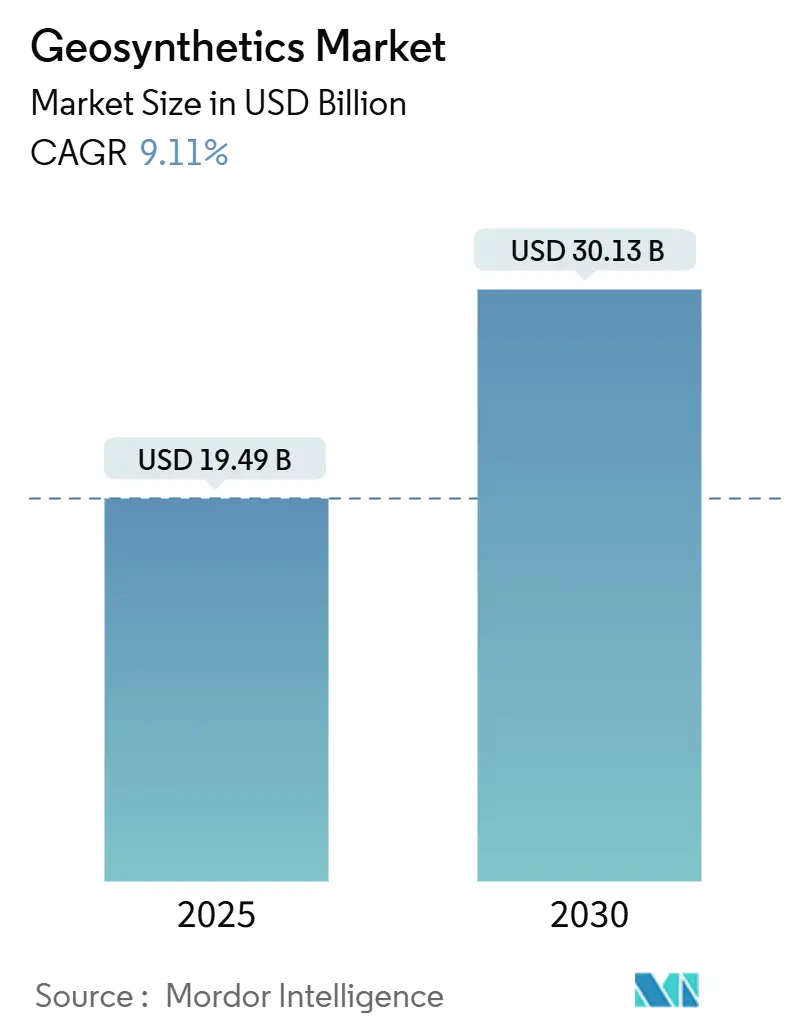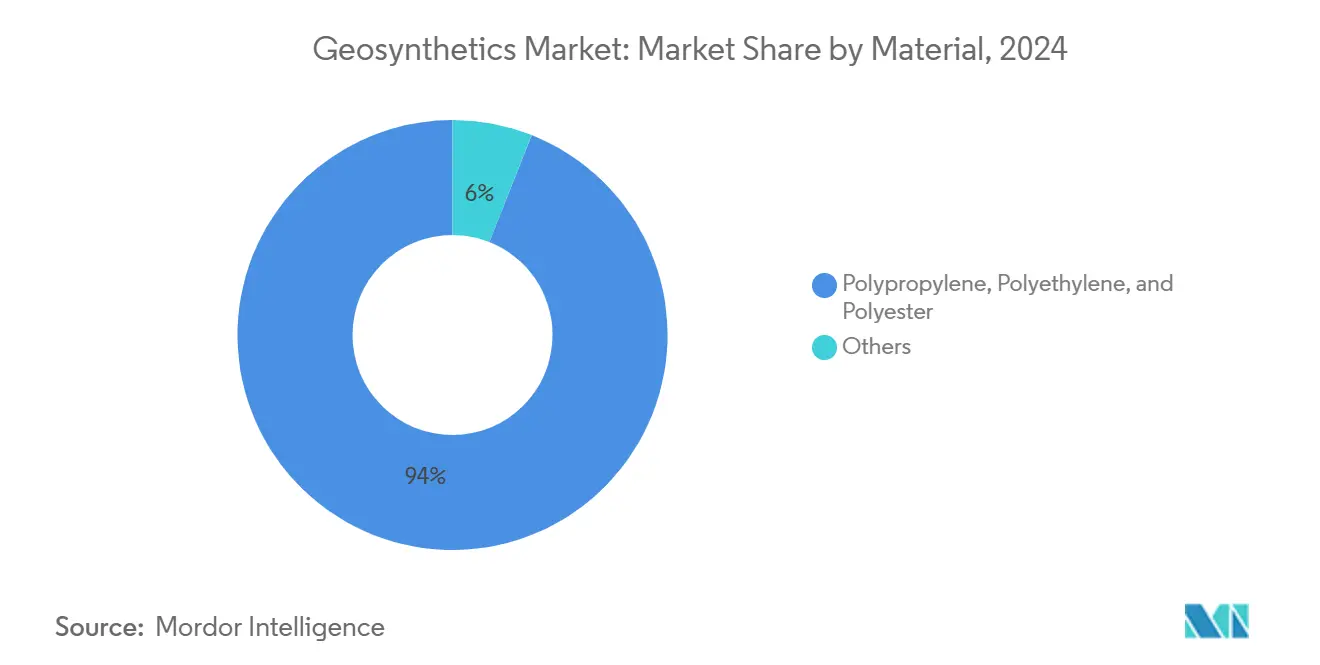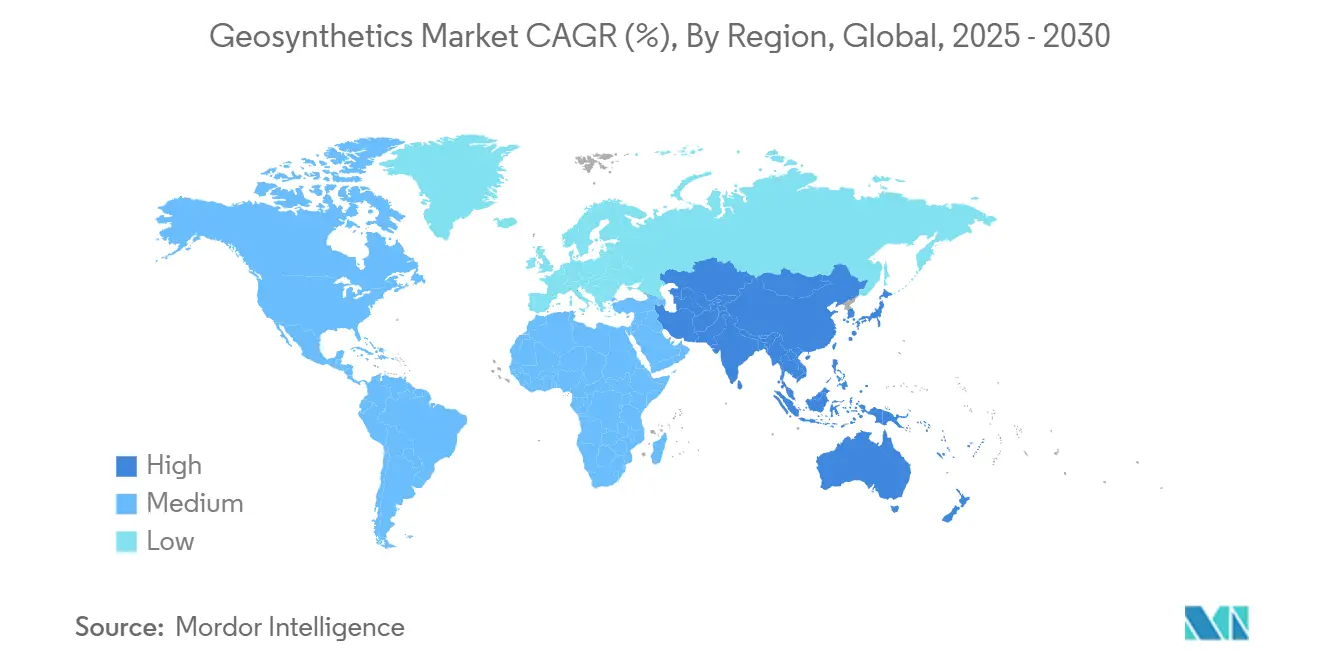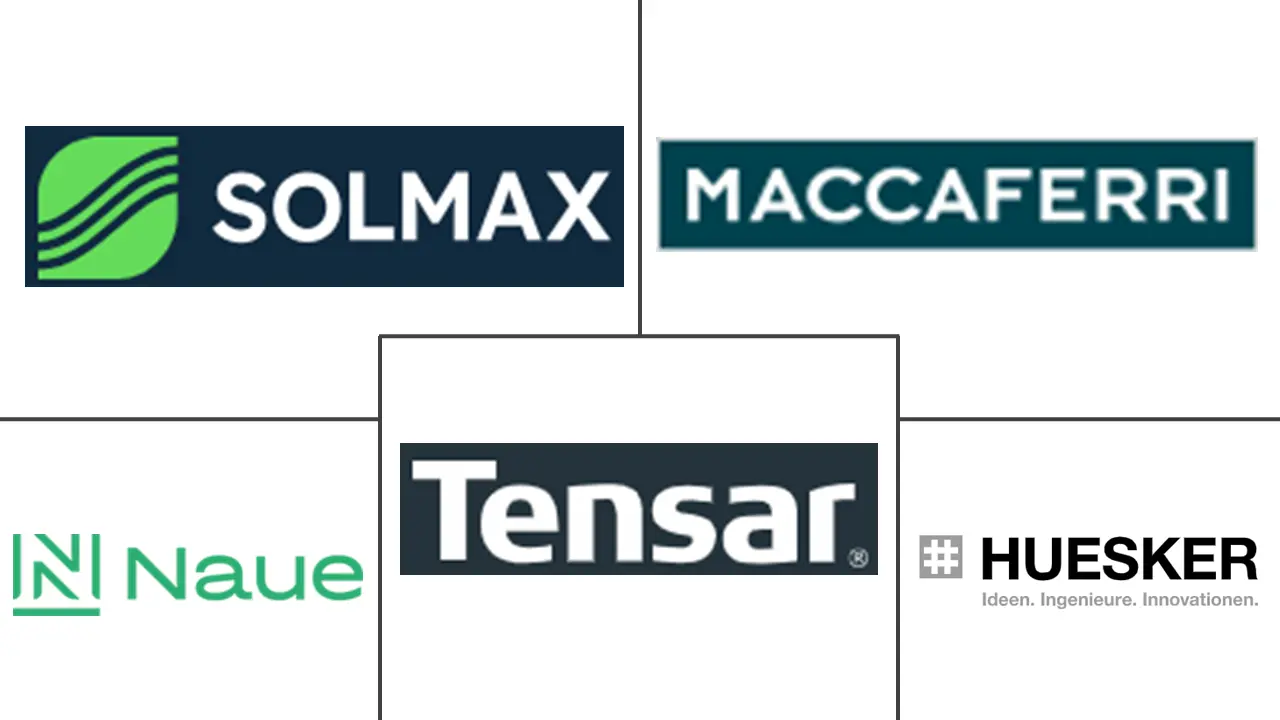Geosynthetics Market Size and Share

Geosynthetics Market Analysis by Mordor Intelligence
The Geosynthetics Market size is estimated at USD 19.49 billion in 2025, and is expected to reach USD 30.13 billion by 2030, at a CAGR of 9.11% during the forecast period (2025-2030). Growth rests on five converging forces. Infrastructure programmes in Asia Pacific, North America, and the Middle East are embedding geosynthetic solutions in roadbeds, retaining walls, and coastal defences because the materials cut aggregate demand and accelerate build schedules. Regulatory bodies in the United States, the European Union, and Japan are mandating stricter containment and filtration standards that favour geomembranes and geotextiles over conventional options. Ongoing R&D in smart materials integrates sensors and recycled polymers to extend service life and enable real-time condition monitoring. Agriculture and mining are emerging end-users, drawn by the erosion-control and tailings-management benefits achieved with newer geogrids and dewatering tubes. Meanwhile, raw-material volatility and evolving European microplastic rules are tempering near-term profitability but also stimulating innovation toward biodegradable or recycled inputs.
Key Report Takeaways
- By material, synthetic polymers commanded 94% of geosynthetics market share in 2024, and are forecast to expand at a 9.1% CAGR through 2030.
- By type, geomembranes led with 35% revenue share in 2024; the same segment is projected to advance at a 10.27% CAGR to 2030.
- By function, reinforcement applications held 32% share of the geosynthetics market size in 2024, whereas containment/barrier functions are growing fastest at a 9.45% CAGR through 2030.
- By application, construction accounted for a 38% share of the geosynthetics market size in 2024; transportation is forecast to expand at a 10.88% CAGR to 2030.
- By geography, Asia Pacific captured 45% of geosynthetics market share in 2024 and is projected to post the highest 9.99% CAGR between 2025-2030.
Global Geosynthetics Market Trends and Insights
Drivers Impact Analysis
| Driver | (~) % Impact on CAGR Forecast | Geographic Relevance | Impact Timeline |
|---|---|---|---|
| Growing Usage of Geotextiles in Construction Industry | +0.5% | Global, notably Asia Pacific and North America | Medium term (2-4 years) |
| Increase Usage of Geotextiles in Mining Activities | +0.3% | Australia, South America, North America, Africa | Short term (≤ 2 years) |
| Stringent Regulatory Framework for Environmental Protection | +0.4% | Europe and North America, expanding in Asia Pacific | Long term (≥ 4 years) |
| Increased Agricultural Applications | +0.2% | Global, emphasis on water-stressed regions | Medium term (2-4 years) |
| Technological Advancements in Material Engineering | +0.3% | Global, led by North America and Europe | Long term (≥ 4 years) |
| Source: Mordor Intelligence | |||
Growing Usage of Geotextiles in Construction Industry
Demand from road, bridge, and foundation projects is elevating the geosynthetics market as contractors replace thicker aggregate layers with geotextile reinforcement that preserves structural capacity while trimming up to 30% of material costs. The U.S. Federal Highway Administration now classifies most geosynthetics as construction materials under the Build America Buy America provisions, triggering mandatory domestic sourcing on federal-aid schemes from March 2025. Urban developers are also selecting geosynthetics for green roofs, where membranes and drainage composites cut stormwater runoff and drop cooling loads by up to 50%. Collectively, these changes underpin a 38% application share in 2024 and sustain long-term momentum for the segment.
Increase Usage of Geotextiles in Mining Activities
Operators of tailings storage facilities are installing composite liners, geogrids, and dewatering tubes to comply with the Global Industry Standards for Tailings Management, thereby reducing liquefaction risks and improving safety records. HUESKER has rolled out purpose-built reinforcement and filtration systems for mine haul roads and waste piles, demonstrating service life gains in Australian operations. As metals demand surges, industry uptake of geosynthetics helps mining account for a growing revenue slice and delivers a 0.3% uplift to the overall CAGR.
Stringent Regulatory Framework for Environmental Protection
The European Commission targets a 30% cut in microplastic leakage by 2030, steering buyers toward low-shed or biodegradable alternatives[1]Source: European Commission, “EU Action Against Microplastics,” maring.org . In the United States, the EPA has endorsed geomembrane-clay composite liners for PFAS isolation, prompting landfill and industrial facilities to upgrade barrier systems. Japan’s G20 marine litter roadmap reinforces similar containment mandates. These policies are pushing R&D into high-performance membranes and recycled-content geotextiles, driving a 0.4% incremental CAGR contribution.
Increased Agricultural Applications
Irrigation efficiency programmes and soil-erosion control measures are extending the geosynthetics market into rural economies. Biodegradable geogrid fabrics derived from Typha domingensis show tensile properties suitable for canal linings while eliminating microplastic residues. Geosynthetic Cementitious Composite Mats prevent runoff on sloped farmland, improving crop yields in trials across India and Brazil. The International Geosynthetics Society and the International Commission on Irrigation and Drainage now jointly promote such applications, broadening market penetration beyond construction.
Restraints Impact Analysis
| Restraint | (~) % Impact on CAGR Forecast | Geographic Relevance | Impact Timeline |
|---|---|---|---|
| Volatile Polypropylene Pricing | -0.4% | Global, especially import-reliant regions | Short term (≤ 2 years) |
| Emerging Europe Micro-plastic Rules Potentially Restricting Conventional Geotextiles | -0.3% | Europe with global spillover | Medium term (2-4 years) |
| Product Standardization Issues | -0.2% | Global, affecting emerging markets | Medium term (2-4 years) |
| Source: Mordor Intelligence | |||
Volatile Polypropylene Pricing
Price swings in polypropylene and HDPE inflate production costs and compress margins across the geosynthetics market. Producers are trialling chemical recycling of used plastics to hedge raw-material risk and lower carbon footprints. Braskem’s 139,000-ton capacity expansion in Brazil may ease supply tightness in Latin America by 2026.
Emerging Europe Micro-plastic Rules
The EU ban on intentionally added microplastics challenges traditional PP-based geotextiles. Draft methodologies to quantify fibre release now shape product-development pathways, urging manufacturers toward coatings or alternative polymers that meet future thresholds.
Segment Analysis
By Material: Synthetic Polymers Retain Dominance While Bio-based Alternatives Gain Traction
Polypropylene, polyethylene and polyester together represented 94% of 2024 revenue and should mirror the overall 9.1% CAGR toward 2030, underscoring their cost-to-performance advantage. This synthetic cohort enjoys well-documented tensile strength, chemical resistance and supply availability, indicators that underpin its leadership in the geosynthetics market. High-density polyethylene geomembranes remain the preferred liner for hazardous-waste cells and heap leach pads under strict EPA protocols.
Rising corporate sustainability commitments are propelling natural-fiber and biodegradable polymer research. Though the segment currently secures a single-digit share, EU regulatory pressure on microplastics is accelerating field trials of plant-based geogrids and PLA-blended nonwovens. Demonstrations with Typha domingensis fibre grids revealed break strengths that satisfy erosion-control design values while allowing full biodegradation within a cropping cycle[2]Source: Luiz Diego VidalSantosa et al., “Geogrid-type geotextile made from Typha domingensis fibers,” doi.org . If validated at scale, these innovations could grow the eco-material slice of the geosynthetics market size at double-digit rates after 2028.

Note: Segment shares of all individual segments available upon report purchase
By Type: Geomembranes Accelerate on Environmental Compliance Momentum
Geomembranes led 2024 turnover with a 35% share and are positioned to register a 10.27% CAGR to 2030, outperforming other product categories in the geosynthetics market. Early adoption in landfill caps has expanded to PFAS containment basins, anaerobic lagoons, and floating-cover reservoir projects that demand near-zero permeability.
Geotextiles remain a large-volume workhorse for filtration and reinforcement. Yet growth is slower as regulatory scrutiny on fibre loss intensifies, spurring material substitutions. Geocomposites and liners that pair drainage cores with geotextiles or membranes are picking up velocity because they combine multiple functions in a thinner profile, appealing to contractors chasing lower excavation volumes and reduced greenhouse-gas footprints. These dynamics imply a gradual redistribution of geosynthetics market share toward multifunctional engineered systems through the forecast window.
By Function: Reinforcement Prevails While Containment Exhibits Highest Growth Curve
Reinforcement commanded 32% of 2024 sales as roads, rail embankments, and mechanically stabilised earth (MSE) walls require stability over weaker subgrades. FHWA research confirms that geosynthetic-reinforced pavement sections cut rut depth by up to 40% under heavy traffic, making reinforcement a backbone of national pavement design guides.
Containment/barrier applications, however, are on track for the fastest 9.45% CAGR. Elevated environmental risk perception, especially around PFAS and mine tailings, mandates composite liners and clay-enhanced membranes that secure leachates. As regulators escalate oversight, containment projects will increasingly underpin the geosynthetics market size expansion. Drainage, filtration and separation functions continue to benefit from niche advances such as wicking fabrics that lower moisture in silty sands by 20%.
By Application: Construction Commands Value While Transportation Sets the Pace
Construction absorbed 38% of 2024 global demand because geosynthetics lower carbon footprints and capital costs in building envelopes, retaining structures, and foundation systems. Comparative lifecycle assessments documented CO₂-emission reductions up to 89% versus all-granular road bases[3]Source: International Geosynthetics Society, “Geosynthetics and Sustainability,” geosyntheticssociety.org .
Transportation infrastructure will deliver the highest 10.88% CAGR. The United States alone expects annual demand to reach 727 million m² by 2030 as state DOTs standardise geosynthetic layers in flexible pavements. Europe’s pioneering geosynthetic reinforced soil bridge abutment in Germany demonstrated 30% cost savings and 25% faster erection, providing a model for broader rollouts. Environmental, agricultural and mining applications collectively contribute a rising share by solving sector-specific water-management and waste-stabilisation challenges.

Note: Segment shares of all individual segments available upon report purchase
Geography Analysis
Asia Pacific held 45% of 2024 revenue and will expand at a 9.99% CAGR as public-sector megaprojects converge with private industrial parks. China’s Belt and Road corridors drive bulk orders for geomembranes in high-speed rail embankments and desert expressways. India’s Smart Cities Mission catalyses municipal landfill upgrades and canal-lining contracts that embed geotextiles in concrete revetments. Japan and South Korea channel R&D into earthquake-resistant retaining walls that combine geosynthetic reinforcement with lightweight fills, reinforcing demand resilience.
North America continues to consolidate end-user uptake, led by the United States’ infrastructure modernisation package. DOT mandates for domestic sourcing of construction materials elevate adoption throughout federal highways, Army Corps flood-control projects and airport runway extensions. Canada’s tailings-dam upgrades in the oil-sand sector and Mexico’s inter-oceanic corridor represent additional growth nodes.
Europe’s stringent circular-economy policies sustain existing penetration yet temper short-term volume gains while producers adapt to microplastic caps. Germany, France and the United Kingdom favour premium geomembranes and geocomposites that meet end-of-life recyclability criteria. Innovators trial biodegradable liners in Scandinavian infrastructure, signalling future shifts in geosynthetics market share toward eco-certified products.
South America and the Middle East & Africa contribute smaller but increasingly strategic volumes. Brazil’s Mineração expansion spurs geosynthetic containment in bauxite residue disposal, whereas Saudi Arabia’s NEOM and Red Sea tourism projects specify geogrids for coastal stabilisation. Multilateral financing for water-harvesting dams and desert road networks underpins a steady demand trajectory across these emerging territories.

Competitive Landscape
The geosynthetics market is highly fragmented, with key players like Solmax, Officine Maccaferri, HUESKER, Tensar dominating geomembrane and high-spec geogrid supply. Mid-tier companies focus on regional niches, offering nonwoven geotextiles and drainage composites. Vertical integration remains critical, as seen in Solmax’s 2024 Houston facility upgrade and Commercial Metals Company’s USD 550 million acquisition of Tensar to secure proprietary geogrid patents. HUESKER’s 2025 acquisition of Sineco International expands its EMEA presence with advanced dewatering and drainage technology. Product innovation, including sensor-enabled membranes and bio-sourced grids, drives differentiation, while sustainability credentials are increasingly vital for procurement. Opportunities lie in biodegradable geosynthetics, integrated monitoring solutions, and renewable-energy applications, with incumbents maintaining an edge through scale advantages in resin sourcing.
Geosynthetics Industry Leaders
-
Huesker International
-
Naue GmbH & Co. KG
-
Officine Maccaferri SpA
-
Solmax
-
Tensar, A Division of CMC
- *Disclaimer: Major Players sorted in no particular order

Recent Industry Developments
- April 2025: HUESKER has acquired Sineco International, expanding its product portfolio with high-quality drainage and dewatering solutions. This move strengthens HUESKER's position in the geosynthetics market.
- January 2025: Officine Maccaferri S.p.A. acquired Synteen Technical Fabrics Inc., strengthening its North American footprint in high-performance geosynthetics.
- December 2024: Solmax revealed plans to centralize its nonwoven geotextile production at a single, advanced facility in the EMEA region, aiming to enhance efficiency and innovation.
- May 2024: Solmax Americas has completed a capacity upgrade at its Houston facility, introducing new extrusion capabilities to boost geomembrane production. This enhancement supports increased output and product performance.
Research Methodology Framework and Report Scope
Market Definitions and Key Coverage
Our study defines the global geosynthetics market as the yearly revenues generated from manufactured polymer-based products, geotextiles, geomembranes, geogrids, geonets, geocells, geofoams, geosynthetic clay liners, and related composites, supplied to construction, transportation, environmental, mining, and agricultural projects. Measurement is in USD, factory-gate, including installation services only when bundled with product sales and reported by vendors.
Scope exclusion: Natural-fiber mats, plastic drainage pipes, and stand-alone installation fees are excluded.
Segmentation Overview
- By Material
- Polypropylene, Polyethylene, and Polyester
- Others
- By Type
- Geotextile
- Geomembrane
- Geocomposite
- Geosynthetic Liner and Others
- By Function
- Separation
- Drainage
- Reinforcement
- Filtration
- Moisture Barrier
- By Application
- Construction
- Transportation
- Environmental
- Other Applications
- By Geography
- Asia-Pacific
- China
- India
- Japan
- South Korea
- Rest of Asia-Pacific
- North America
- United States
- Canada
- Mexico
- Europe
- Germany
- United Kingdom
- France
- Italy
- Rest of Europe
- South America
- Brazil
- Argentina
- Rest of South America
- Middle East and Africa
- Saudi Arabia
- South Africa
- Rest of Middle East and Africa
- Asia-Pacific
Detailed Research Methodology and Data Validation
Primary Research
Mordor analysts interviewed civil engineers at roadway authorities, procurement managers from major landfill operators, polymer resin distributors, and project consultants across Asia Pacific, North America, Europe, and the Gulf. Dialogues clarified average selling prices, functional preference shifts (for example, the switch from non-woven to composite liners), and adoption rates of recycled polymers, which were then contrasted with desk findings to refine assumptions.
Desk Research
We began with open datasets that anchor demand drivers: US Federal Highway Administration project awards, Eurostat construction output, China's National Bureau of Statistics infrastructure mileage, United Nations Comtrade polymer export flows, and landfill counts published by the U.S. EPA. Company filings, investor decks, and patent families retrieved through Questel added insight on new resin blends. Subscription tools such as D&B Hoovers and Dow Jones Factiva provided financials and press mentions that confirmed vendor shipments. These sources, together with trade association briefs from the International Geosynthetics Society and the World Road Association, frame historical baselines and regional mix. The list is indicative; many further publications supported data checks and gap fills.
Market-Sizing & Forecasting
A top-down install-area reconstruction, built from kilometers of paved roads, square meters of landfill caps, and ore tonnage tailings capacity, delivered the first cut. Results were corroborated through selective bottom-up supplier roll-ups and channel checks to align volumes with sampled ASP multiplied by shipped area. Key variables like HDPE resin price index, new road lane-kilometers, mining capital spend, regulatory landfill cell additions, and average material utilization per function drive our multivariate regression forecast. Scenario analysis adjusts for resin volatility and infrastructure stimulus windows; in regions lacking granular data, interpolation from adjacent markets bridged small gaps.
Data Validation & Update Cycle
Analysts subject model outputs to variance screens against import statistics, quarterly vendor revenues, and construction-material price trackers. Senior reviewers question anomalies before sign-off. The dataset refreshes every twelve months, with interim updates triggered by material events such as sharp oil price moves or landmark infrastructure packages. A last-mile sense check is completed prior to each client delivery.
Why Mordor's Geosynthetics Baseline Inspires Confidence
Published market values often differ; definitions shift, coverage varies, and refresh cadences diverge.
Key gap drivers include whether revenues from geofoams and clay liners are counted, the treatment of bundled installation, differing ASP escalation rules, and update frequency. Mordor reports current-year actuals, while some firms anchor forecasts to older bases or narrower product baskets, leading to inevitable spread.
Benchmark comparison
| Market Size | Anonymized source | Primary gap driver |
|---|---|---|
| USD 19.49 B (2025) | Mordor Intelligence | - |
| USD 17.59 B (2025) | Global Consultancy A | Excludes geofoams and clay liners; adjusts prices only biennially |
| USD 17.93 B (2025) | Industry Forecasting B | Bundled installation omitted; relies on 2023 base without mid-cycle revisions |
These contrasts show that Mordor's disciplined inclusion of all polymer-based geosynthetics, live ASP tracking, and annual refresh provide a balanced, transparent baseline that decision-makers can reliably trace back to clear variables and repeatable steps.
Key Questions Answered in the Report
What is the current size and growth outlook for the geosynthetics market?
The global geosynthetics market stands at USD 17.86 billion in 2024 and is forecast to reach USD 30.13 billion by 2030, reflecting a 9.11% CAGR over 2025-2030.
Which product type is expected to expand the fastest?
Geomembranes hold the largest 35% share in 2024 and are projected to grow at the highest 10.27% CAGR through 2030, driven by stringent environmental containment rules.
How will transportation projects influence demand?
Transportation applications are set for a 10.88% CAGR, outpacing all other segments as governments adopt geosynthetic reinforcement to cut roadbed costs and carbon footprints.
Why is Asia Pacific the dominant regional market?
Asia Pacific commands 45% of 2024 revenue and should post a 9.99% CAGR thanks to China’s Belt and Road investments and India’s Smart Cities Mission, both of which specify geosynthetics in large-scale infrastructure.
What raw-material risks should procurement teams watch?
Volatile polypropylene and HDPE prices can compress margins, producing a –0.4% drag on forecast CAGR; several suppliers are pursuing recycled feedstocks to mitigate exposure.
Which sustainability trends will reshape competitive positioning?
Biodegradable polymers, sensor-enabled membranes, and recycled-content geogrids are emerging as procurement criteria as regulators target a 30% microplastic-leakage cut by 2030 in the European Union.
Page last updated on:



